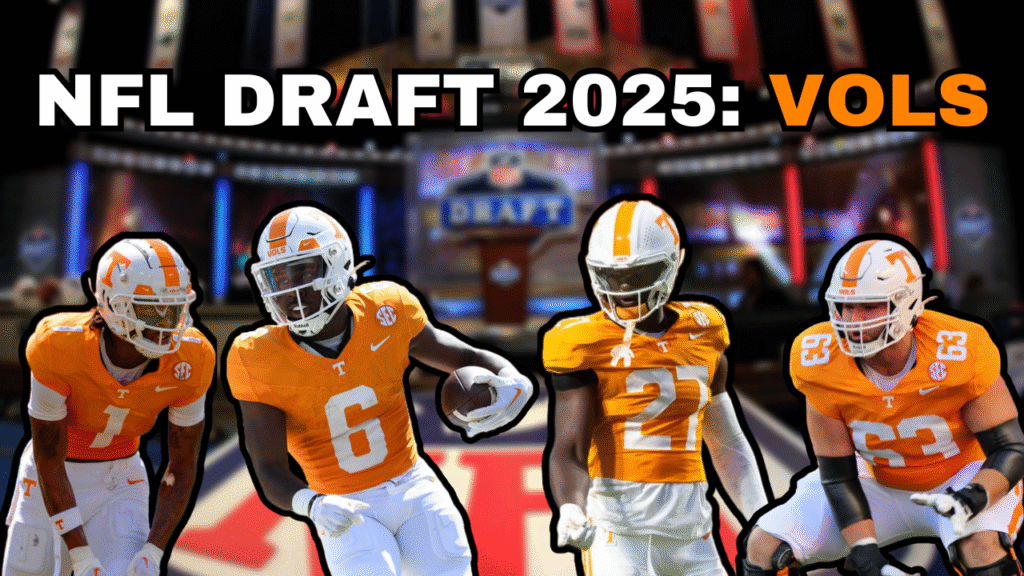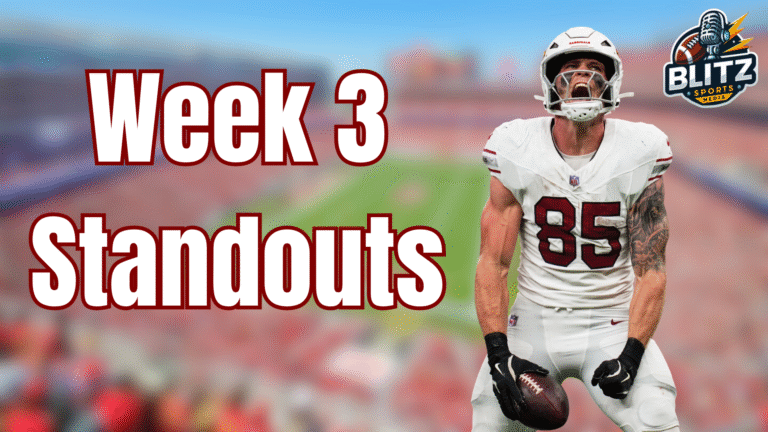
The 2025 NFL Draft is less than a week away, and several Tennessee Volunteer players hope to hear their names called on draft night.
Tennessee has a long history of NFL talent. Since the draft’s inauguration in 1936, Tennessee has had 378 players drafted into the NFL. Of those players, 46 have been first-round picks, including two first-overall selections. During this period, the Vols have had a player drafted every year besides 1938, 1960, 1963, 2015, 2016, and 2019.
So, as we wait to see which Vols players get selected in this year’s draft, here are a few names to keep an eye on:
James Pearce Jr.
- Height: 6′ 5″
- Weight: 245 lbs
- 40 Time: 4.47 sec
- Vertical: 31″
- Broad Jump: 10′ 3″
- Bench Press: N/A
James Pearce Jr. is arguably one of the biggest questions surrounding the 2025 NFL Draft. Once considered a No. 1 overall pick, Pearce’s stock has fallen since alleged reports of character issues from NFL insiders. Although no details of these reports have been released, the circulation of rumors has caused Pearce’s stock to crumble.
In addition to the alleged character concerns, draft scouts are also worried about Pearce’s size. Although Pearce stands at an impressive height of 6-5, scouts worry that his narrow frame contributes to his inability to gain weight. The average weight of an NFL defensive end is anywhere from 260 to 310 pounds, and Pearce is listed at 245 pounds. It is safe to say that Pearce will need to gain weight to hold his own against NFL offensive tackles.
Regardless of the concerns mentioned, Pearce possesses elite speed from the edge position. During the 2025 NFL Combine, Pearce had the quickest time among defensive linemen, clocking a blazing 4.47 seconds in the 40-yard dash.
Pearce’s explosiveness and shifty acceleration earned him 19.5 sacks and 30 tackles for a loss during his time with the Volunteers. There are countless instances of Pearce beating offensive tackles before they got out of their stances. His ability to time up snap counts contributed to his elite pass-rushing skills.
However, Pearce will need to gain substantial weight to become more well-rounded as a lineman. His lack of mass made it difficult for Pearce to be as effective at defending the run. If he adds at least 20 pounds after being drafted, he should flourish in the NFL.
Considering the dip in Pearce’s draft stock, seeing which team takes a chance on him in the draft will be fascinating. Some mock drafts have had Pearce drafted as low as the second round, but don’t be shocked if a team selects him within the first 15 picks.
Dylan Sampson
- Height: 5’8”
- Weight: 200lbs
- 40 Time: 4.42 sec (Pro Day)
- Vertical: 35″
- Broad Jump: 10′ 4″
- Bench Press: 13 reps
After solidifying his status as a Tennessee football legend, former Vols running back Dylan Sampson is one of the most exciting Volunteers to monitor in the draft. In 2024, Sampson broke a litany of team records, including the most rushing yards (1,491) and rushing touchdowns (22) in a season. His on-the-field success during last year helped crown him as SEC Player of the Year, and now he is trying to find his place in the 2025 NFL Draft.
Although he was one of the best players in college football last season, you may be surprised to learn that most NFL analysts don’t see Sampson as a top-five running back in this year’s draft. ESPN draft expert Mel Kiper Jr. listed Sampson as the sixth-best running back in the draft, and ESPN had him as the seventh-best available running back in the draft.
So, why is Sampson rated so low even after a legendary college career? Well, there are a few reasons:
One reason is that Sampson was underutilized in Tennessee’s passing attack. During his three-year career, Sampson only eclipsed 150 yards receiving once in a season. In addition, Sampson has only recorded one receiving touchdown with the Volunteers. In a pass-friendly league such as the NFL, Sampson will need to become a bigger option in the passing game.
Another question from NFL scouts is whether Sampson can become more effective as an outside runner. In Tennessee’s offense, Sampson was primarily used in between-the-tackle runs. This tactic served him well in college, but Sampson will likely need to become a more well-rounded runner to maximize his potential in the NFL.
Although Sampson needs to improve in a couple of categories, there are still many upsides for the former Vols running back. One of Sampson’s best traits is his speed. During Tennessee’s Pro Day, Sampson ran a 4.42 second 40-yard-dash and is rumored to run anywhere from 22-23 miles per hour through the Vols’ Catapult system.
Outside of Sampson’s speed, he is also an elusive runner. Throughout his college career, he has shown the ability to make effective cuts. He was always capable of bouncing plays to the outside for explosive runs. As a result, 929 of Sampson’s 1,491 rushing yards came after initial contact in 2024.
Sampson has also shown a strong prowess in short-yardage situations. Many of his touchdowns came in goal-line scenarios, and he also excelled at gaining first downs.
If anyone doubts how Sampson fares against NFL talent, during his junior season, Sampson accumulated 1,051 yards and 12 touchdowns against SEC opponents alone.
Although Sampson has fallen under the radar in the draft, he could become a valuable asset for a team in the second or third round. Sampson will likely get drafted between the second and third rounds of the NFL Draft.
Cooper Mays
- Height: 6’2″
- Weight: 305 lbs
- 40 Time: 5.1 sec (Pro Day)
- Vertical: N/A
- Broad Jump: N/A
- Bench Press: 26 reps (Pro Day)
Seemingly forgotten by many, former Tennessee center Cooper Mays is another Vols player hoping to be drafted. In 2024, Mays was an All-American center who finished as a semifinalist for Rimington Trophy (award for the best center).
Throughout 2,962 career snaps, Mays only allowed five sacks during his Tennessee career. He also held a 26-game streak without giving up a sack.
Mays comes from a family full of football talent. For two seasons, his older brother Cade Mays played alongside him while at Tennessee, and he currently plays offensive guard for the Carolina Panthers. In addition, Mays’s father Kevin played for the Vols alongside Peyton Manning and was an All-SEC offensive guard who was a team captain in 1994.
So, why is an All-American center with a family legacy of talented offensive linemen being overlooked in this year’s draft? Well, one of the reasons is that Mays is a tad undersized. Mays is listed at 6-2, and some scouts worry that he lacks the length to create separation against the big nose tackles in the NFL.
Another concern is Mays’s injury history. Throughout his college career, Mays missed nine games with injuries, including hernia surgery that sidelined him for four games in 2023.
Although Mays isn’t the biggest or most athletic offensive lineman in this year’s draft, he is still a solid leader who has started against SEC competition since freshman year. May’s playing experience, alongside his powerful blocking skills, makes him an underrated player in the draft.
Mays is projected to go undrafted, but don’t be surprised if a team takes a chance on him in the later draft rounds.

Dont’e Thornton Jr.
- Height: 6’5″
- Weight: 205 lbs
- 40 Time: 4.3 sec
- Vertical: 33″
- Broad Jump: 10′ 6″
- Bench Press: N/A
Dont’e Thornton Jr. is an under-the-radar wide receiver prospect in the 2025 NFL Draft. The long, 6-5 receiver is a nightmare matchup for defensive backs. In addition to his length, Thornton possesses world-class speed, clocking a 4.3-second 40-yard dash at the NFL Combine.
Thornton accumulated 1,426 receiving yards and 10 touchdowns throughout his four-year college career, including six touchdown catches in 2024. Although his stats don’t jump out on paper, the lanky receiver is more than capable of being a productive receiver.
Thornton’s combination of world-class speed and imposing height makes him a dangerous threat in vertical situations, so much so that he averaged 21.9 yards per catch in college.
Besides being a deep threat, Thornton hasn’t been as effective in short-yard situations. Most of Thornton’s catches came from deep passes across the middle and from vertical routes. To become a primary wide receiver on an NFL roster, he must grow in other aspects besides deep plays.
However, Thornton could become a valuable contributor if a team is searching for a second or third receiver who can stretch plays down the field. Currently, Thornton is projected to go in the fourth round. If that is the case, then whatever team drafts him may have found a hidden gem.




